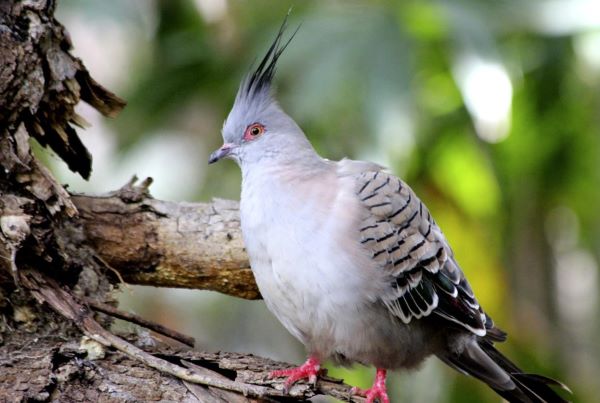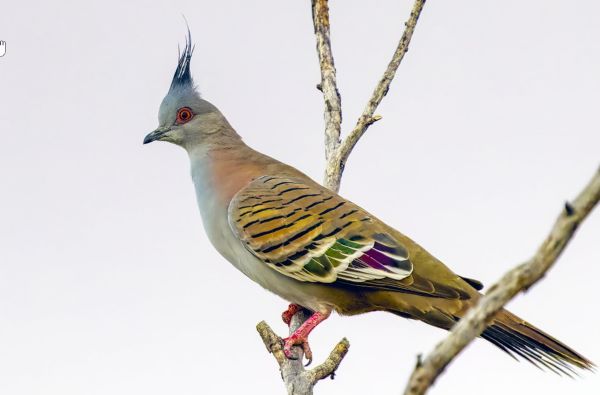Family: The crested pigeon (Geophaps tophotes) is a member of the pigeon family Columbidae in the genus Ocyphaps.
Habitat: In most parts of their range, crested pigeons live in dry, lightly wooded grasslands. They avoid all dense forests, and in central Australia, they prefer the moister areas, such as timber-fringed watercourses. However, golf courses, farmhouse gardens, pastoral areas, sports grounds, and watercourses are also places where they might be observed. The crested pigeon and the spinifex pigeon are the only two species of pigeons native to Australia that have an upright crest. This pigeon has benefited from human settlement wherever very large areas that were formerly thick scrub and closed woodland have been cleared for crops and grazing, leaving scattered trees ideal for roosting and nesting. The birds have been able to advance from the inland across the slopes of the Great Dividing Range in the east, even to the coast, and in the south and west, they have reached Adelaide and penetrated the Western Australian wheat belt in the past 50 years.
Identification: Both adult sexes are identical. The crown is grey with a darker, erect crest. Back and rump grey with olive tinge; upper side of tail dusky with green tinge, white tip. Wings fawn with black barring on shoulders and purple and green iridescent patches edged white below; flight feathers dusky. The throat and breast are light grey; belly and underside of the tail are darker grey. The eyes are red-orange, and the skin around the eye is red. The bill is black, and the feet are pink-red. The immature bird is duller in tone and has more marks. The downy young is fawn to cream.
Diet: The primary food source for crested pigeons, which are herbivores (granivores), is a variety of seeds, though they may also eat some leaves and insects. Inland, Crested Pigeons live around country homesteads, nesting in windbreaks along watercourses and feeding on the plains. On the coast, they are found on small, intensely worked farms, feeding with pigs and poultry, or on the verges of roads. Ground-feeders and seed-eaters eat little else than seeds from crops and exotic weeds over much of their rural range. No doubt, their ability to adapt to such food has helped their coasts spread.
Distribution: Crested pigeons are common throughout most of mainland Australia, except in the coastal southwest, southeast, and far north. Vagrants may wander to all regions. Populations on the coast and in districts of intense cultivation inland are sedentary, but in more arid countries they are locally nomadic.
Behavior: Although they are usually seen in groups of five or six, they often gather in large numbers in bushes near a waterhole. They wait until one or two pluck up the courage to fly to the ground and run in, with heads bobbing, to drink. The rest will then follow. When flushed, they burst off with a loud wing clatter but seldom go far before alighting together on a bare branch. On display, crested pigeons are like other bronze wings and even more spectacular in the bow, spreading their patterned tails vertically. They also have a distinctive display flight: clapping up from a perch, the bird rises steeply for about 30 meters and then glides straight down again. This has been thought to put the Crested Pigeon in a separate genus, but its red eye skin, crest, barred shoulders, and gliding flight reveal that it is no more than a derived ground bronzewing, Geophaps. When interacting with humans, these birds become extremely sociable.
Vocalizations: The crested pigeon has a characteristic whistling “call” when it takes flight. The air rushing over a modified main feather on the wings causes this noise. Crested Pigeon identity call is a loud, wavering coo; in contact, a low musical coo; males utter a sharp coo at the low point of each bow in their bowing display.
Flight: The flight is swift and direct, with rapid whistling wing beats interspersed with periods of gliding on down-spread wings. On alighting, they swing the tail high above the body momentarily. Crested pigeon whistling wingbeats could be a warning signal or created by a specifically constricted third primary.
Nesting and Breeding: The crested pigeon nesting and breeding occur mostly in spring and early summer, but anytime after rainfall. Nest a frail platform, about 170 mm in diameter, of fine sticks placed seldom more than 4-5 meters above ground on a horizontal fork, usually in a low, thickly foliaged bush. Breeding all year long, with a peak during the warmer months, crested pigeons are paired off and monogamous. When a male approaches a female, they initiate a complex mating dance in which they bob their bodies up and down, opening and closing their wings like a fan with each bob, and time their soft hooting to match. If the female is interested, she stays mostly motionless until the male tries to copulate.
Eggs and Incubation: Crested Pigeon lays two eggs, smooth, glossy white, oval, about 31 x 23 mm. The incubation period is about 19–20 days for both sexes. Young fledge in 20–25 days. May rear up to seven successive broods, breeding continuously for several months.
Other Names: This pigeon is also known as Topknot Pigeon and Crested Bronzewing.
Size: Crested pigeons measure about 300–340 mm in length and weigh about 160–250 grams.
Races: There are two races,
-
l. lophotes in Western Australia, north to Pilbara, with vestigial white tail tips.
-
The other O. l. whitlocki, with broad white-tipped tails everywhere else, occurs in regions of the center and north of WA.
Taxonomy: The crested pigeon was named by Temminck in 1822. As per G.R. Gray’s 1842 classification, this is the only species in the genus Ocyphaps.
Status: There are no major threats to this species. Hence, the IUCN Red List now lists this species as least concern (LC); however, it is becoming more common.
Read More: Bleeding Heart Dove – Blood Run Down Bird Breast











